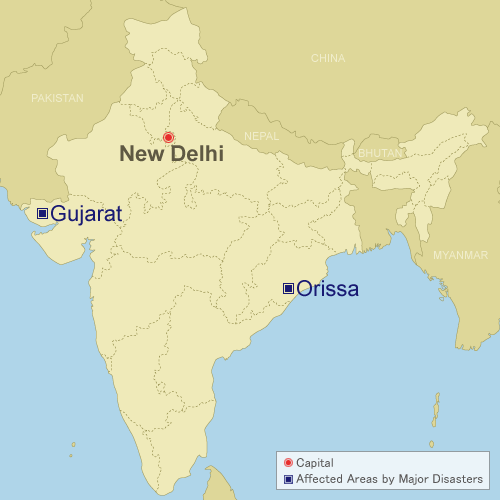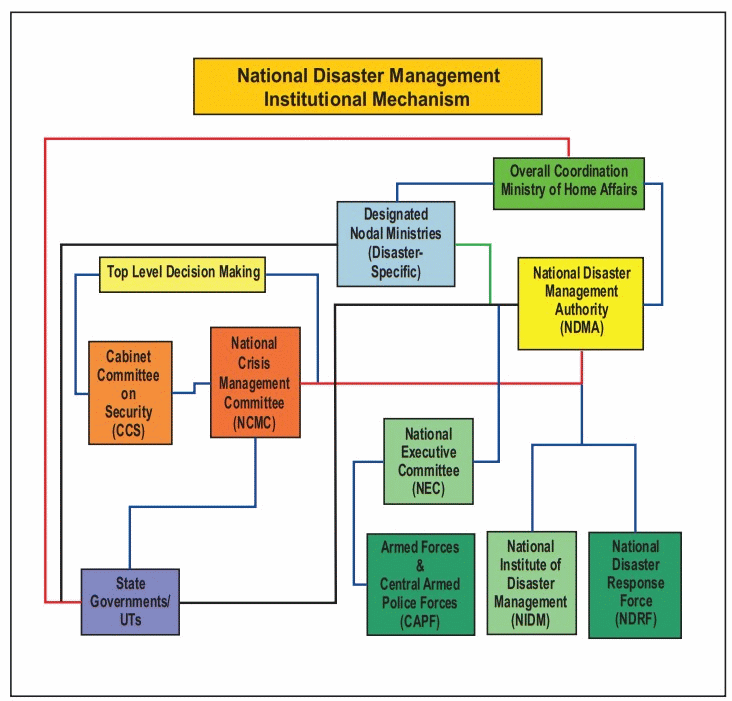TOP PAGE > Information on Disaster Risk Reduction of the Member Countries
Information on Disaster Risk Reduction of the Member Countries
 India
India
General Information
 Formal Name: Republic of India
Formal Name: Republic of IndiaWith 3,287,263 sq km land, India occupies most of the Indian subcontinent. It borders with Pakistan, Afghanistan, China, Nepal, Bhutan, Bangladesh, and Myanmar on land, Sri Lanka, Maldives, Indonesia at sea. There is upland plain (Deccan Plateau) in south, flat to rolling plain along the Ganges, deserts in west, Mountainous strips in the northeast and Himalayas in north.
New Delhi is the capital city. The population of India is estimated to have reached 1363.0 million in 2021 and consists of a variety of religious, linguistic and ethnic groups.
Overview of Disasters
India has been vulnerable, in varying degrees, to a large number of natural, as well as, human-made disasters on account of its unique geo-climatic and socio- economic conditions. It is highly vulnerable to floods, droughts, cyclones, earthquakes, landslides, avalanches and forest fires. Out of 36 states and union territories in the country, 27 of them are disaster prone. Almost 58.6 per cent of the landmass is prone to earthquakes of moderate to very high intensity; over 40 million hectares (12 per cent of land) are prone to floods and river erosion; of the 7,516 km long coastline, close to 5,700 km is prone to cyclones and tsunamis; 68 per cent of the cultivable area is vulnerable to drought and hilly areas are at risk from landslides and avalanches.
Recent Major Disasters
Indian Ocean Tsunami (December 2004)
The Indian Ocean Tsunami which took place off the Sumatra Island on 26 December 2004 killed 16,389 people, injured 6,913 people and affected about 65 million people. The total damage is about US10 billion.
Gujarat Earthquake (January 2001)
M7.7 earthquake occurred in Gujarat Province (western India) on 26 January 2001. At least 20,005 people were killed, 166,812 injured, approximately 360,000 buildings destroyed and 15 million people affected in Gujarat. The total damage is US4.6 billion.
Orissa Super Cyclone (October 1999)
A massive cyclone that hit Orissa (northeast of India) on 29 October 1999 killed 9,887, affected approximately 13 million people, and destroyed 800,000 houses.
Disaster Management System
Legal System
The Disaster Management Act, 2005 was enacted on 26 December 2005 on the first anniversary of the devastating tsunami of 2004. The Act provides a legal and institutional framework for “the effective management of disasters and for matters connected therewith or incidental thereto.”
The Act provides for the establishment of National Disaster Management Authority (NDMA), State Disaster Management Authority (SDMA) and District Disaster Management Authorities (DDMA), as well as National Institute of Disaster Management (NIDM) and National Disaster Response Force (NDRF).
Organization
 While the primary responsibility of disaster management rests with the States, the Central Government supports the efforts of State Governments by providing logistical and financial support.
On behalf of the Central Government, Disaster Management Division in the Ministry of Home Affairs coordinates with disaster affected State Government(s), concerned line ministries/departments, National Disaster Management Authority (NDMA), National Disaster Response Force (NDRF), National Institute of Disaster Management (NIDM) and the Directorate General of Fire Services, Home Guards and Civil Defence, and Armed Forces for effective disaster risk reduction. The Division is responsible for legislation, policy, capacity building, prevention, mitigation, response and long-term rehabilitation.
While the primary responsibility of disaster management rests with the States, the Central Government supports the efforts of State Governments by providing logistical and financial support.
On behalf of the Central Government, Disaster Management Division in the Ministry of Home Affairs coordinates with disaster affected State Government(s), concerned line ministries/departments, National Disaster Management Authority (NDMA), National Disaster Response Force (NDRF), National Institute of Disaster Management (NIDM) and the Directorate General of Fire Services, Home Guards and Civil Defence, and Armed Forces for effective disaster risk reduction. The Division is responsible for legislation, policy, capacity building, prevention, mitigation, response and long-term rehabilitation. Plan
The National Policy on Disaster Management was approved by the Government in November 2009. This comprehensive policy document lays down policies on every aspect of holistic management of disasters in the country. The main aim the policy espouses to achieve is to minimize the losses to lives, livelihoods and property, caused by natural or manmade disasters with a vision to build a safe and disaster resilient India by developing a holistic, proactive, integrated, multi-disaster oriented and technology driven strategy.
In order to promote a systematic of mainstreaming DRR in development agendas, the National Disaster Management Plan was developed in 2016, taking into account of SFDRR, SDG, and Paris Agreement of Climate Change. It has short, medium, and long-term measures that will completed within the time frames of 5, 10 and 15 years. This plan was revised in 2019.
In order to promote a systematic of mainstreaming DRR in development agendas, the National Disaster Management Plan was developed in 2016, taking into account of SFDRR, SDG, and Paris Agreement of Climate Change. It has short, medium, and long-term measures that will completed within the time frames of 5, 10 and 15 years. This plan was revised in 2019.
ADRC Counterpart
Country Report
Country Report 2024 (English Version, PDF file)Country Report 2023 (English Version, PDF file)
Country Report 2022 (English Version, PDF file)
Country Report 2020 (English Version, PDF file)
Country Report 2018 (English Version, PDF file)
Country Report 2015 (English Version, PDF file)
Country Report 2012 (English Version, PDF file)
Country Report 2008 (English Version, PDF file)
Country Report 2006 (Japanese Version, PDF file)
Country Report 2006 (English Version, PDF file)
Country Report 2002 (English Version, PDF file)
Country Report 1999 (English Version, PDF file)
Country Report 1999 (Japanese Version, PDF file)
Country Report 1998 (English Version, PDF file)
Disaster Information (The latest 10)
・2024/12/01 : Tropical Cyclone
・2024/10/24 : Tropical Cyclone, Flood
・2024/05/26 : Tropical Cyclone

